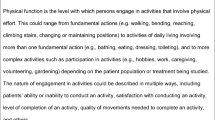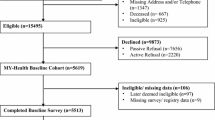Abstract
Purpose
The U.S. Food & Drug Administration has identified physical functioning (PF) as a core patient-reported outcome (PRO) in cancer clinical trials. The purpose of this study was to identify PF PRO measures (PROMs) in adult cancer populations and classify the PROMs by content covered (facets of PF) in each measure.
Methods
As part of the Patient Reports of Physical Functioning Study (PROPS) research program, we conducted a targeted literature review to identify PROMs that could be used in clinical trials to evaluate PF from the patient perspective. Next, we convened an advisory panel to conduct a modified, reactive, Delphi study to reach consensus on which PF facets are assessed by PROMs identified in the review. The panel engaged in a “card sort” activity to classify PROM items by PF facets. Consensus was reached when 80% of panel members agreed that at least one facet was being measured by each PROM item.
Results
The literature review identified 13 PROMs that met inclusion criteria. Eight facets of PF were identified for classification in the Delphi study: ability, completion, difficulty, limitation, quality, frequency, bother, and satisfaction. Through two rounds, the panel documented and classified conceptual approaches for each PRO item presented. The most prevalent PF facets were ability, difficulty, and limitation.
Conclusion
Classifying PF PROMs by PF facets will promote more consistent communication regarding the aspects of PF represented in each PROM, helping researchers prioritize measures for inclusion in cancer clinical trials.






Similar content being viewed by others
Data availability
Due to the small sample sizes included in qualitative studies, sharing transcripts or other data could identify an individual. Therefore, these data are not publicly available.
References
Pinheiro, L. C., & Reeve, B. B. (2018). Investigating the prognostic ability of health-related quality of life on survival: a prospective cohort study of adults with lung cancer. Supportive Care in Cancer, 26(11), 3925–3932. https://doi.org/10.1007/s00520-018-4265-3
Pinheiro, L. C., Zagar, T. M., & Reeve, B. B. (2017). The prognostic value of pre-diagnosis health-related quality of life on survival: A prospective cohort study of older Americans with lung cancer. Quality of Life Research, 26(7), 1703–1712. https://doi.org/10.1007/s11136-017-1515-7
Braun, D. P., Gupta, D., & Staren, E. D. (2011). Quality of life assessment as a predictor of survival in non-small cell lung cancer. BMC Cancer, 11(1), 353. https://doi.org/10.1186/1471-2407-11-353
U.S. Food and Drug Administration. (2021). Core Patient-Reported Outcomes in Cancer Clinical Trials. Draft Guidance for Industry. June 2021. Retrieved August 10, 2023 from https://www.fda.gov/regulatory-information/search-fda-guidance-documents/core-patient-reported-outcomes-cancer-clinical-trials
Kluetz, P. G., Slagle, A., Papadopoulos, E. J., Johnson, L. L., Donoghue, M., Kwitkowski, V. E., Chen, W. H., Sridhara, R., Farrell, A. T., Keegan, P., Kim, G., & Pazdur, R. (2016). Focusing on core patient-reported outcomes in cancer clinical trials: Symptomatic adverse events, physical function, and disease-related symptoms. Clinical Cancer Research, 22(7), 1553–1558. https://doi.org/10.1158/1078-0432.Ccr-15-2035
Schurr, T., Loth, F., Lidington, E., Piccinin, C., Arraras, J. I., Groenvold, M., Holzner, B., van Leeuwen, M., Petersen, M. A., Schmidt, H., Young, T., Giesinger, J. M., Arraras, J. I., Groenvold, M., van Leeuwen, M., & European Organisation for Research, T. o. C. Q. o. L. G. (2023). Patient-reported outcome measures for physical function in cancer patients: Content comparison of the EORTC CAT Core, EORTC QLQ-C30, SF-36, FACT-G, and PROMIS measures using the International Classification of Functioning, Disability and Health. BMC Medical Research Methodology, 23(1), 21. https://doi.org/10.1186/s12874-022-01826-z
World Health Organization. (2001). International Classification of Functioning, Disability and Health (ICF). Retrieved January 16, 2024 from https://www.who.int/standards/classifications/international-classification-of-functioning-disability-and-health
Bruce, B., Fries, J., Lingala, B., Hussain, Y. N., & Krishnan, E. (2013). Development and assessment of floor and ceiling items for the PROMIS physical function item bank. Arthritis Research & Therapy, 15(5), R144. https://doi.org/10.1186/ar4327
Hancock, K. J., Glass, N., Anthony, C. A., Hettrich, C. M., Albright, J., Amendola, A., Wolf, B. R., & Bollier, M. (2017). Performance of PROMIS for Healthy Patients Undergoing Meniscal Surgery. Journal of Bone and Joint Surgery American, 99(11), 954–958. https://doi.org/10.2106/jbjs.16.00848
DeWalt, D. A., Rothrock, N., Yount, S., & Stone, A. A. (2007). Evaluation of item candidates: The PROMIS qualitative item review. Medical Care, 45(5 Suppl 1), S12-21. https://doi.org/10.1097/01.mlr.0000254567.79743.e2
Jensen, R. E., Potosky, A. L., Reeve, B. B., Hahn, E., Cella, D., Fries, J., Smith, A. W., Keegan, T. H., Wu, X. C., Paddock, L., & Moinpour, C. M. (2015). Validation of the PROMIS physical function measures in a diverse US population-based cohort of cancer patients. Quality of Life Research, 24(10), 2333–2344. https://doi.org/10.1007/s11136-015-0992-9
Aaronson, N. K., Ahmedzai, S., Bergman, B., Bullinger, M., Cull, A., Duez, N. J., Filiberti, A., Flechtner, H., Fleishman, S. B., de Haes, J. C., &, et al. (1993). The European Organization for Research and Treatment of Cancer QLQ-C30: A quality-of-life instrument for use in international clinical trials in oncology. Journal of the National Cancer Institute, 85(5), 365–376. https://doi.org/10.1093/jnci/85.5.365
Kronish, I. M., Thorpe, C. T., & Voils, C. I. (2019). Measuring the multiple domains of medication nonadherence: Findings from a Delphi survey of adherence experts. Translational Behavioral Medicine. https://doi.org/10.1093/tbm/ibz133
National Cancer Institute. Group-Evaluated Measures (GEMs). [Website] Retrieved August 11, 2023 from https://cancercontrol.cancer.gov/brp/research/group-evaluated-measures
U.S. Food and Drug Administration. Clinical Outcome Assessment Compendium. [Website] Retrieved August 11, 2023 from https://www.fda.gov/drugs/development-resources/clinical-outcome-assessment-compendium
Shirley Ryan Ability Lab. Rehabilitation Measures. [Website] Retrieved August 11, 2023 from https://www.sralab.org/rehabilitation-measures
Mapi Research Trust. ePROVIDE. [Website] Retrieved January 19, 2023 from https://eprovide.mapi-trust.org/
National Library of Medicine. ClinicalTrials.gov. [Website] Retrieved August 11, 2023 from https://clinicaltrials.gov/
Northwestern University. HealthMeasures. [Website] Retrieved August 11, 2023 from https://www.healthmeasures.net/
Schalet, B. D., Hays, R. D., Jensen, S. E., Beaumont, J. L., Fries, J. F., & Cella, D. (2016). Validity of PROMIS physical function measured in diverse clinical samples. Journal of Clinical Epidemiology, 73, 112–118. https://doi.org/10.1016/j.jclinepi.2015.08.039
Bruce, B., & Fries, J. F. (2003). The Stanford Health Assessment Questionnaire: Dimensions and practical applications. Health and Quality of Life Outcomes, 1, 20. https://doi.org/10.1186/1477-7525-1-20
Ware, J. E., Jr., & Sherbourne, C. D. (1992). The MOS 36-item short-form health survey (SF-36). I. Conceptual framework and item selection. Medical Care, 30(6), 473–483.
Hunt, S. M., McKenna, S. P., McEwen, J., Backett, E. M., Williams, J., & Papp, E. (1980). A quantitative approach to perceived health status: A validation study. Journal of Epidemiology and Community Health, 34(4), 281–286. https://doi.org/10.1136/jech.34.4.281
Bergner, M., Bobbitt, R. A., Carter, W. B., & Gilson, B. S. (1981). The sickness impact profile: Development and final revision of a health status measure. Medical Care, 19(8), 787–805. https://doi.org/10.1097/00005650-198108000-00001
[Record #176 is using a reference type undefined in this output style.]
Hudak, P. L., Amadio, P. C., Bombardier, C., Beaton, D., Cole, D., Davis, A., Hawker, G., Katz, J. N., Makela, M., Marx, R. G., Punnett, L., & Wright, J. (1996). Development of an upper extremity outcome measure: The DASH (disabilities of the arm, shoulder, and head). American Journal of Industrial Medicine, 29(6), 602–608. https://onlinelibrary.wiley.com/doi/abs/10.1002/%28SICI%291097-0274%28199606%2929%3A6%3C602%3A%3AAID-AJIM4%3E3.0.CO%3B2-L
Jette, A. M., Davies, A. R., Cleary, P. D., Calkins, D. R., Rubenstein, L. V., Fink, A., Kosecoff, J., Young, R. T., Brook, R. H., & Delbanco, T. L. (1986). The Functional Status Questionnaire: Reliability and validity when used in primary care. Journal of General Internal Medicine, 1(3), 143–149. https://doi.org/10.1007/bf02602324
Wilkie, R., Peat, G., Thomas, E., Hooper, H., & Croft, P. R. (2005). The Keele Assessment of Participation: A new instrument to measure participation restriction in population studies. Combined qualitative and quantitative examination of its psychometric properties. Quality of Life Research, 14(8), 1889–1899. https://doi.org/10.1007/s11136-005-4325-2
Mader, L., Post, M. W., Ballert, C. S., Michel, G., Stucki, G., & Brinkhof, M. W. (2016). Metric properties of the Utrecht Scale for Evaluation of Rehabilitation-Participation (USER-Participation) in persons with spinal cord injury living in Switzerland. Journal of Rehabilitation Medicine, 48(2), 165–174. https://doi.org/10.2340/16501977-2010
Parkerson, G. R., Jr., Gehlbach, S. H., Wagner, E. H., James, S. A., Clapp, N. E., & Muhlbaier, L. H. (1981). The Duke-UNC Health Profile: An adult health status instrument for primary care. Medical Care, 19(8), 806–828. https://doi.org/10.1097/00005650-198108000-00002
Schipper, H., Clinch, J., McMurray, A., & Levitt, M. (1984). Measuring the quality of life of cancer patients: The Functional Living Index-Cancer: Development and validation. Journal of Clinical Oncology, 2(5), 472–483. https://doi.org/10.1200/jco.1984.2.5.472
Chambers, L. W., Sackett, D. L., Goldsmith, C. H., Macpherson, A. S., & McAuley, R. G. (1976). Development and application of an index of social function. Health Services Research, 11(4), 430–441.
Verbrugge, L. M., & Jette, A. M. (1994). The disablement process. Social Science & Medicine, 38(1), 1–14. https://doi.org/10.1016/0277-9536(94)90294-1
Acknowledgements
We would like to extend our gratitude to the panel members who generously shared their valuable insights and expertise. Their contributions have been instrumental in the evolution of how we understand the measurement of physical function, and we are deeply grateful for their time and effort in engaging in meaningful discussions. Panel members included Claudio Battaglini, Vishal Bhatnagar, Nicki Bush, Alicyn Campbell, Cynthia Chauhan, Lori Denison, Amylou Dueck, Shana Harrington, Roxanne Jensen, Hanna Sanoff, and Siva Sundaresan. The authors would also like to acknowledge Liz Wing for editorial support.
Funding
This work was supported by the U.S. Food & Drug Administration (FDA) of the U.S. Department of Health and Human Services (HHS) (Contract 75F40120C00069). The contents are those of the author(s) and do not necessarily represent the official views of, nor an endorsement, by FDA/HHS, or the U.S. Government.
Author information
Authors and Affiliations
Contributions
TC contributed to conceptualization, funding acquisition, methodology, interpretation of results, and writing of the original draft. RF, KP, AH, and DH contributed to data collection, analysis, interpretation of results, and writing, reviewing and editing of the manuscript. CA and SC: data collection and writing, reviewing, and editing of the manuscript. SL-D, RG, TL, VB, and EH contributed to interpretation of results and writing, reviewing, and editing of the manuscript. BR contributed to methodology, interpretation of results, and writing, reviewing, and editing of the manuscript. KW contributed to conceptualization, methodology, interpretation of results, and writing, reviewing, and editing of the manuscript.
Corresponding author
Ethics declarations
Conflicts of Interest
TC has research funding from Merck and Pfizer, a prior consulting agreement with Regenxbio and received a speaking honorarium from ISPOR. CA was a fellow at Duke (2021–2023) funded by AstraZeneca and is now an employee at AstraZeneca (2023-present).CRG is a consultant for Stryker and Medtronic. BBR had a consulting role with Novartis. TWL has received honoraria for consulting/advisory boards from AbbVie, Agilix, Agios/Servier, Apellis, Astellas, AstraZeneca, BlueNote, BMS/Celgene, Genentech, GSK, Lilly, Meter Health, Novartis, and Pfizer; speaking related honoraria from AbbVie, Agios, Astellas, BMS/Celgene, Incyte, and Rigel; equity interest in Dosentrx (stock options in a privately-held company); royalties from UpToDate; research funding from the AbbVie, American Cancer Society, AstraZeneca, BMS, Deverra Therapeutics, Duke University, GSK, Jazz Pharmaceuticals, and Seattle Genetics. TWL is a Scholar in Clinical Research of the Leukemia & Lymphoma Society. All other authors have no disclosures.
Additional information
Publisher's Note
Springer Nature remains neutral with regard to jurisdictional claims in published maps and institutional affiliations.
Supplementary Information
Below is the link to the electronic supplementary material.
Rights and permissions
Springer Nature or its licensor (e.g. a society or other partner) holds exclusive rights to this article under a publishing agreement with the author(s) or other rightsholder(s); author self-archiving of the accepted manuscript version of this article is solely governed by the terms of such publishing agreement and applicable law.
About this article
Cite this article
Coles, T., Fillipo, R., Plyler, K. et al. Facets of physical function assessed by patient-reported outcome measures in oncology research. Qual Life Res (2024). https://doi.org/10.1007/s11136-024-03640-0
Accepted:
Published:
DOI: https://doi.org/10.1007/s11136-024-03640-0




